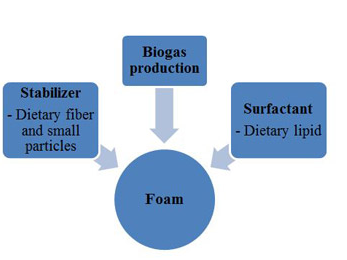



Effect of Diet Composition and Particle Size on Nutrient Excretion of Finishing Pigs and Propensity to Cause Manure Pit Foaming
Fibre composition in soybean hulls has a greater impact on manure-foaming capability than the fibre in DDGS, report Zhaohui Luo, Pedro Urriola, Bo Hu, and Gerald Shurson of the University of Minnesota and Brian Kerr of USDA-ARS. They also found that diets of larger particle size increased the manure-foaming capability of the feed.Manure pit foaming on commercial swine farms has been a significant problem in recent years. Two of the most obvious problems caused by foaming manure are dirty pigs and reducing manure pit storage volume. Of even greater concern is that hydrogen sulphide gas is trapped in foam, and when it is released, barn concentrations can easily exceed Occupational Safety and Health Administration permissible exposure limits, which are lethal to pigs and humans. Methane gas is also trapped in this foam.
Methane is flammable and has been implicated as the underlying cause of several barn explosions (referred to as flash fires) in Minnesota, Iowa, and Illinois. This has caused significant concern related to the health and safety of barn workers and pigs housed in these farms. Manure pit foaming on commercial swine farms has been a significant problem in recent years.
Production and accumulation of foam in swine manure pits appears to be due to three main factors:
- production of biogas
- presence of a surfactant, and
- presence of a stabiliser of foam.
Indigestible nutrients excreted in faeces of pigs may supply the necessary compounds that contribute to these three factors.
Based on preliminary evidence from the University of Minnesota, incomplete digestion of dietary lipids may serve as the surfactant to initiate foaming, and undigested dietary fiber and hydrophobic particles may stabilise the foam bubbles. In addition, a high concentration of fiber in manure can be fermented in anaerobic pits and increase biogas production.
To understand better the effect of diet composition on manure foaming capability, researchers at the University of Minnesota and USDA-ARS conducted a study which components of pig diets may be causative factors for manure foaming. The objective of this experiment was to measure nutrient excretion and manure foaming capability of pigs fed diets containing three sources and amounts of dietary fiber and lipid, and ground at two particle sizes.
Two groups of 24 growing gilts with initial body weight of 263 lbs were placed into metabolism crates and randomly allotted to one of six dietary treatments.
Dietary treatments consisted of:
- corn-soybean meal (CSB)
- CSB + 35 per cent DDGS (DDGS), and
- CSB + 21 per cent soybean hulls (SBH).
Diets were ground to a mean particle size of 374 microns (fine) or 631 microns (coarse) and fed for seven weeks.
Faeces were collected to determine digestibility of dry matter, fibre and lipid. Faeces and urine were mixed daily and stored in simulated deep pit storage tanks and manure foaming capability was measured.
Greater manure-foaming capability was observed for pigs fed the coarse SBH diet than those fed fine CSB and SBH but not for fine or coarse DDGS.
Faecal excretion of dry matter and fibre were greater in pigs fed DDGS and SBH diets than in pigs fed the CSB diet. Faecal excretion of lipid was greater for pigs fed the DDGS diet than pigs fed CSB or SBH diets. Feeding diets with coarse particle size resulted in greater faecal excretion of dry matter, fibre and lipid than finely-ground diets.
In conclusion, fibre composition in soybean hulls has a greater impact on manure-foaming capability than the fibre composition in DDGS, and larger diet particle size reduces dry matter, fibre and lipid digestibility causing increased content in manure and manure-foaming capability.
December 2014










